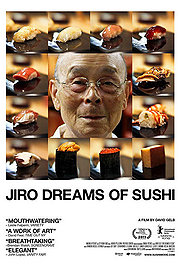
In a subway station in Tokyo, there is a Japanese sushi bar that has become legendary in the culinary world. Its owner and chef, Jiro, is a shokunin (a master in a profession) and the world’s first sushi chef to be awarded 3-stars from Michelin. He has been listed in the Guinness Book of World Records and continues seeking improvement after making sushi for over 75 years.
Jiro Dreams of Sushi, a 2011 documentary, tells the behind-the-scenes story of Jiro’s love for sushi, his depth of knowledge, and his dedication to mastery. The documentary was followed by many articles that summarized lessons gleaned from the film.
What can writers, artists, and others working in creative fields learn from Jiro? The ideas presented in this documentary are timeless and relevant in many fields beside sushi-making.
Developing Your Skills
1. “Once you decide on your occupation, you must immerse yourself in your work. You have to fall in love with your work.” – Jiro
- After over 7 decades of making-sushi, Jiro remains deeply passionate about sushi-making. He does not want to take holidays or retire, and even states that if he stopped working, he would be totally bored.
- He does not simply tell people to “find their passion”, but rather to “fall in love” and stay committed—his relationship with his work is not a one-time fling, but a life-long love that has deepened over time.
Relevance to the arts: Writers and artists often start doing creative work out of passion and interest. However, as challenges arise, whether creative blocks, rejections, lack of time, or financial difficulties, we are often reluctant to commit to our art. Our interest can start waning as other problems get in the way and we become tempted to abandon our dreams.
Questions to consider: What do you most enjoy about your art? How committed are you to your projects? How can you immerse yourself more deeply in your work?
2. Everyone starts out as an apprentice. Dedicate yourself to mastering skills.

- Jiro entered the sushi-making trade at a young age. His apprentices, including his two sons, all undergo a rigorous 10-year apprenticeship (an interesting parallel to the 10,000-rule first popularized by Malcolm Gladwell, which has been highly-debated).
- Apprentices began by learning how to wring a hot towel with their hands, then progress to cutting the fish, preparing sushi, and eventually conquer the challenging task of making tamago (egg) sushi.
- An apprentice was asked to make tamago sushi more than 200 times over 4 months before his sushi was deemed acceptable.
Relevance to the arts: Many of us crave to be skilled and recognized for our abilities. But this process of becoming good at anything can take a long time, and even the best writers and artists we admire started out as beginners. Rather than rush through learning, we need to dedicate time and energy to building our fundamental skills.
Questions to consider: What skills do you need to acquire to become better at what you do? Who can you learn from? How can design your own apprenticeship?
3. Both talent and hard work matter.
- “There are some who are born with a natural gift. Some have a sensitive palate and sense of smell,” Yoshikazu, Jiro’s oldest son, states as he prepares seaweed for making sushi. “… In this line of business, if you take it seriously, you’ll become skilled. But if you want to make a mark in the world, you have to have talent. The rest depends on how hard you work.”
Relevance to the arts: People are sometimes born with variations in ability; some might have a knack for stringing words together, a keener ear for singing in tune, or a sharp eye for framing photos. Yet, hard work is necessary and can take you a long way, regardless of your natural-born ability. Masters in their fields combine their strengths with dedication to the craft.
Questions to consider: What are your strengths? How can you build on them? How can you integrate practice into your life?
Approaches to Working
4. “I would see ideas in dreams… In dreams, I would have visions of sushi.” — Jiro

- With his obsessive love for sushi and improvement, Jiro is constantly thinking about making sushi, and he even dreams about sushi in his sleep.
- He has applied these ideas to his work and invented many new dishes.
Relevance to the arts: We can often find inspiration in our dreams, surroundings, and daily life. Use your imagination and daydreams to help you develop a vision of your completed work and then find ways to make it happen.
Questions to consider: Where do you normally find ideas? What are some new places where you can search for inspiration? What project do you dream of working on?
5. Be detailed-oriented, observant, and adaptable.
- At the start of each day, Jiro checks everything in his sushi bar to ensure smooth operation and pre-arranges the seating plan for reversed customers.
- When he serves sushi, he modifies his sushi-making to adapt to the needs of his customers; for instance, he makes sushi for customers one piece at a time as they eat, and if he notices a customer is left-handed, he would place the sushi on the left side rather the right.
Relevance to the arts: Focusing on details can help you bring a piece of writing and artwork to the next level. Take time to think about how you use diction, syntax, and rhythm in your writing. When telling a story or creating a painting, capture details, such as the way light glints through a stained glass window or the light footsteps of a puppy trotting through the woods. Find ways to improve overlooked details, whether in regards to materials, technique, subject, or distribution.
Questions to consider: What preparation can you do to support your creativity and work? Where do details matter most in your work? What small touches can you add to bring your work to the next level?
6. “Simplicity leads to purity” – Yamamoto, Japanese food critic

- This poetic saying by Yamamoto encapsulates Jiro’s method of making sushi and running a business.
- He uses methods that are known to everyone, but applies them with experience and expertise. He has also simplified his menu and serves only sushi, after realizing that appetizers filled up customers quickly and detracted from their experience.
- Chefs from around the world are amazed at how his seemingly-simple sushi can taste so delicious.
Relevance to the arts: You do not need fancy vocabulary or the most advanced techniques to create a stunning story or artwork. Instead, simplicity can allow for a greater focus on what’s most important—the ideas and emotions that you want to convey to your audience. Furthermore, as you gain a better awareness of your strengths and interests, decide on a niche/specialization and focus on becoming the best in that one area.
Questions to consider: What is the main idea, emotion, or message that you are trying to convey in your work? How can you highlight that by simplifying your approach or techniques? What is your niche? What can you eliminate so that you have time and energy to focus on your specializations?
The ideas presented in this blog post are fundamental to my personal philosophies as a writer and tutor. Thank you so much to everyone who has stopped by. I’m amazed by all the new likes, comments, and shares, and glad for how many people this blog post has touched.
Keep Reading Part 2: 12 Lessons for Writers and Artists from Jiro Dreams of Sushi
If you enjoyed this post, I would recommend checking out these others:



Just being curious here. When are you planning to post lessons 6 through 12?
hey, thanks for checking. I ran into some delays and I’m finishing it up so I plan to have it up for tomorrow.
[…] from Jiro Dreams of Sushi”. I’m sorry for being late in posting part 2. If you missed part 1, please read that first. Thanks for […]
Loved the movie. Thank you for reminding me of it and for this neat synopsis of relevant tips. Welcome.
Thanks a lot! I am happy you enjoyed the documentary too.
This is nicely done and I loved the comparisons between Jiro’s work and the craft of writing. I also now want to come to Tokyo and eat sushi at his restaurant.
Yes, I have visited Tokyo before but didn’t know about his restaurant. Would love to go try it someday.
Great post. You definitely incorporated what you learned from Jiro.
Thanks! 🙂 I am trying my best. Personally I find we all learn by example. I also learn from my reader’s comments what works and doesn’t, so appreciate you dropping by.
[…] 12 Lessons for Writers and Artists from Jiro Dreams of Sushi (Part 1/2) […]